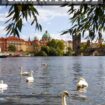
Go World Travel is reader-supported and may earn a commission from purchases made through links in this piece.
Prague has become one of the most popular tourist destinations in Europe. Before the pandemic in 2020, approximately 8 million tourists per year were making their way to the “City of a Hundred Spires”.
In part, to admire its century’s worth of astounding architecture and history. Now that travel to Europe is rebounding, similar crowds can be expected in this tourist hot spot.
This typically means that during peak travel season, you will be shoulder to shoulder with fellow tourists. Especially in the most popular places like Old Town Square or Prague Castle.
However, just short distances from the popular sites lie neighborhoods just as charming with only a fraction of the visitors. Here’s a guide on how to find them.
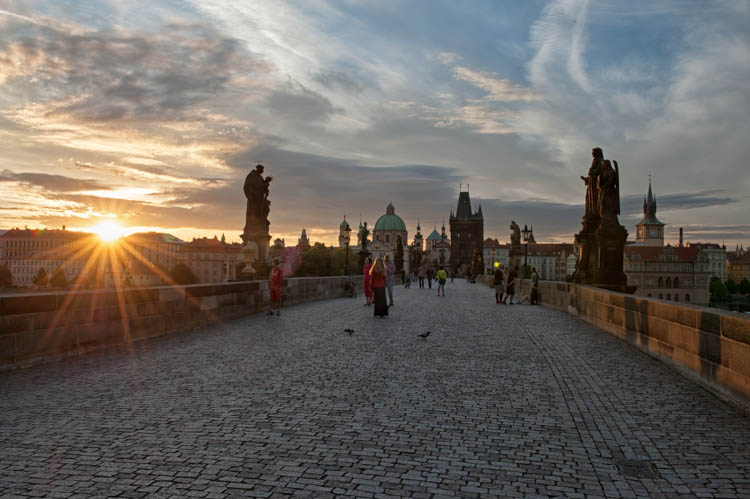
Finding Hidden Gems in Prague
Start by following the crowds crossing the Charles Bridge that connects Old Town with Castle hill. Just before reaching the western bank of the Vltava River, look for a stone staircase leading downward.
Descend it and you’ll find a peaceful neighborhood of Baroque palaces and gardens that have changed little since the 18th century.
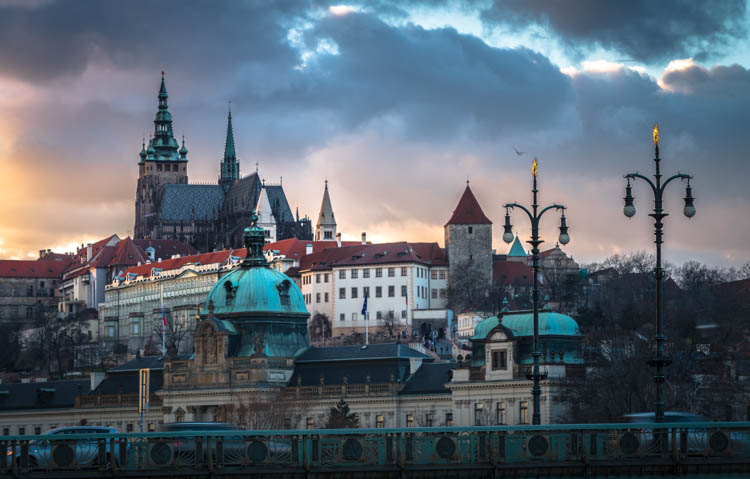
Malá Strana
Known as Malá Strana, or “Little Quarter,” it’s a neighborhood of winding streets that rise sharply from the river to the castle. Many of its grand palaces are now embassies.
Along Nerudova Street, one of the quarter’s main thoroughfares, look for heraldic emblems and fantastical beasts above the doors denoting the former names of the buildings. Names such as “The Red Lion,” “The Little Fiddles,” “The Golden Horseshoe” or “At the Three Ostriches.”
A highlight of the quarter includes Saint Nicholas Church. This Baroque gem is where Mozart once played the organ. It’s also said that KGB spies in the belfry watched the goings on at the nearby American embassy.
The Kafka Museum pays homage to Prague’s most famous literary personage. The works of bizarre and surrealistic fiction are reflected in the museum’s “Imaginary Topography” exhibit, reimagining Prague from Kafka’s troubled point of view.
The Czech Music Museum has displays of everything from Neapolitan mandolins and antique lutes to electric guitars and early synthesizers. Listen on headsets to music played on them and be sure to check out the concerts frequently held in the main hall.
In addition, it’s worth taking the trouble to find the “Lennon Peace Wall” in Grand Priory Square. It began as a spontaneous tribute of colorful graffiti honoring John Lennon when he was murdered in 1980.
The vivid murals painted on the long wall have been repeatedly whitewashed by the authorities, only to be repainted almost immediately by guerilla street artists. The authorities have long since given up trying to stop the tributes.
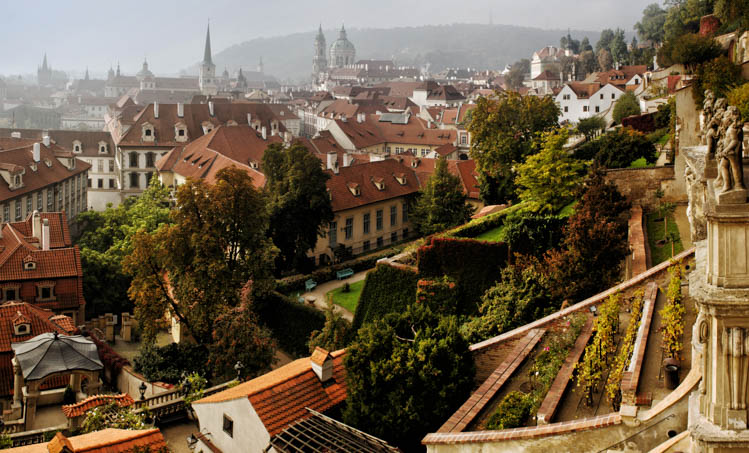
Secret Gardens in Prague
Also, many of those palatial buildings you pass frequently have secret gardens that can be visited. The Wallenstein Garden, with bronze statues, strolling peacocks and a carp pond is free to visit. Near its enormous Italianate loggia is a grotto of faux stalactites.
And don’t miss the Palace Gardens, one of Prague’s best hidden gems. A series of five interlocking gardens directly beneath Prague Castle, they’re dotted with little pavilions, statuary, and fountains. There are also several terraces offering a fantastic view of the Old Town across the river.
From Malá Strana, you’ll see another wooded hill rising above in addition to the promontory where Prague Castle sits. Take the winding pathways or ride the funicular to the top of Petřín Hill. Here you’ll encounter an octagonal lookout tower that resembles the Eiffel Tower but is one-fourth its size.
Spectacular views of Prague can be had from its summit. Also, check out other sites in the surrounding park which include a mirror maze and an observatory. On clear nights you can see the jagged edges of the moon’s craters through its telescope.
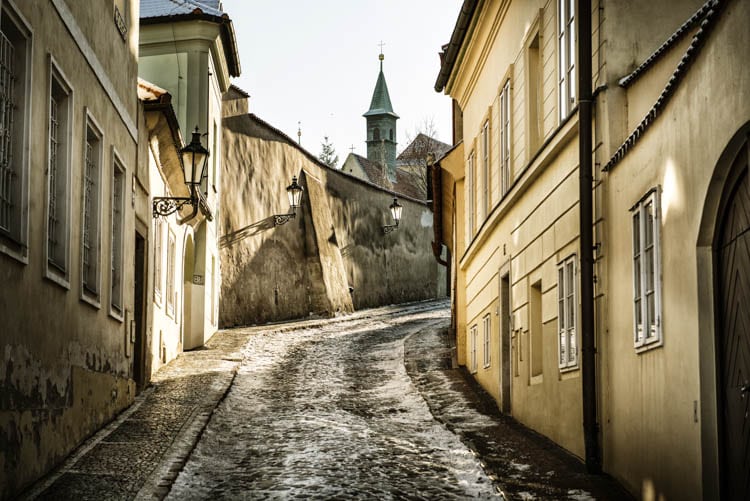
Hidden Gems Near Hradčany
From here it’s an easy walk to Hradčany, the neighborhood surrounding the castle. Best of all, you’ll be approaching it from the opposite direction from all the hordes of tourists. On the way, two overlooked sites are worth visiting.
The Strahov Monastery has an 800-year-old library housed in two breathtaking halls with frescoed ceilings. Also on site is the Museum of Miniatures which includes The Lord’s Prayer written on a human hair and a caravan of camels passing through the eye of a needle.
Nearby, the Loreta Church is a place of pilgrimage due to its “Santa Casa,” a replica of Mary’s house in Nazareth. A collection of rare liturgical objects on display includes “The Prague Sun,” encrusted with 6,222 diamonds.
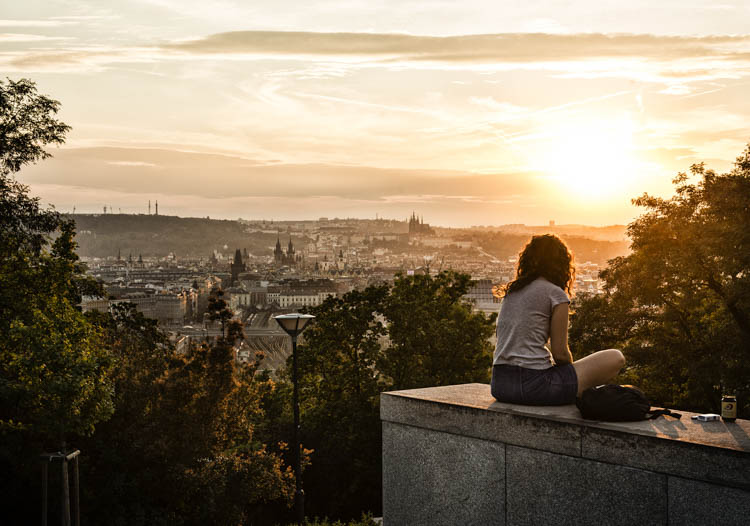
Holešovice, Vinohrady and Vyšehrad
Other enchanting neighborhoods virtually undiscovered by tourists lie both to the north and the south of the central city. To the north, the arts district of Holešovice was once an industrial neighborhood whose factories are now being converted into hip galleries and nightclubs.
Especially notable is the Dox Centre for Contemporary Art, which highlights video, sculpture, photography and painting. Also the National Gallery inside the Veletržní Palace, a former trade fair exposition hall.
Its premier collection of modern art includes works by Van Gogh, Picasso, Klimt, and Munch. In addition, it has an especially strong collection of contemporary Czech art, including 20 oversized canvases illustrating “The Slav Epic.”
To the south of the central city, the quiet, residential neighborhood of Vinohrady has streets lined with late 19th-century apartment blocks. These include ones constructed in the Art Nouveau style.
The elegant hotels here won’t have the hustle and bustle or traffic noise of hotels more centrally located. However, you’ll still be within easy reach of the major sites on foot or by public transportation.
Likewise, the genuinely authentic restaurants and pubs of this neighborhood offer typical local cuisine and Czech beers, reputed to be among the finest in the world.
Nearby, the neighborhood of Vyšehrad has a hilltop park with the remains of an ancient fortress. Also here are statues of Bohemian folklore figures in a cemetery that’s the burial place of such Czech luminaries as Antonín Dvořák, composer of the “New World Symphony”. Plus, you’ll find a cluster of unusual Czech cubist villas.
Furthermore, the ramparts of the fortress are a great place to watch the setting sun behind Prague Castle from a place almost guaranteed to be free of throngs of tourists.
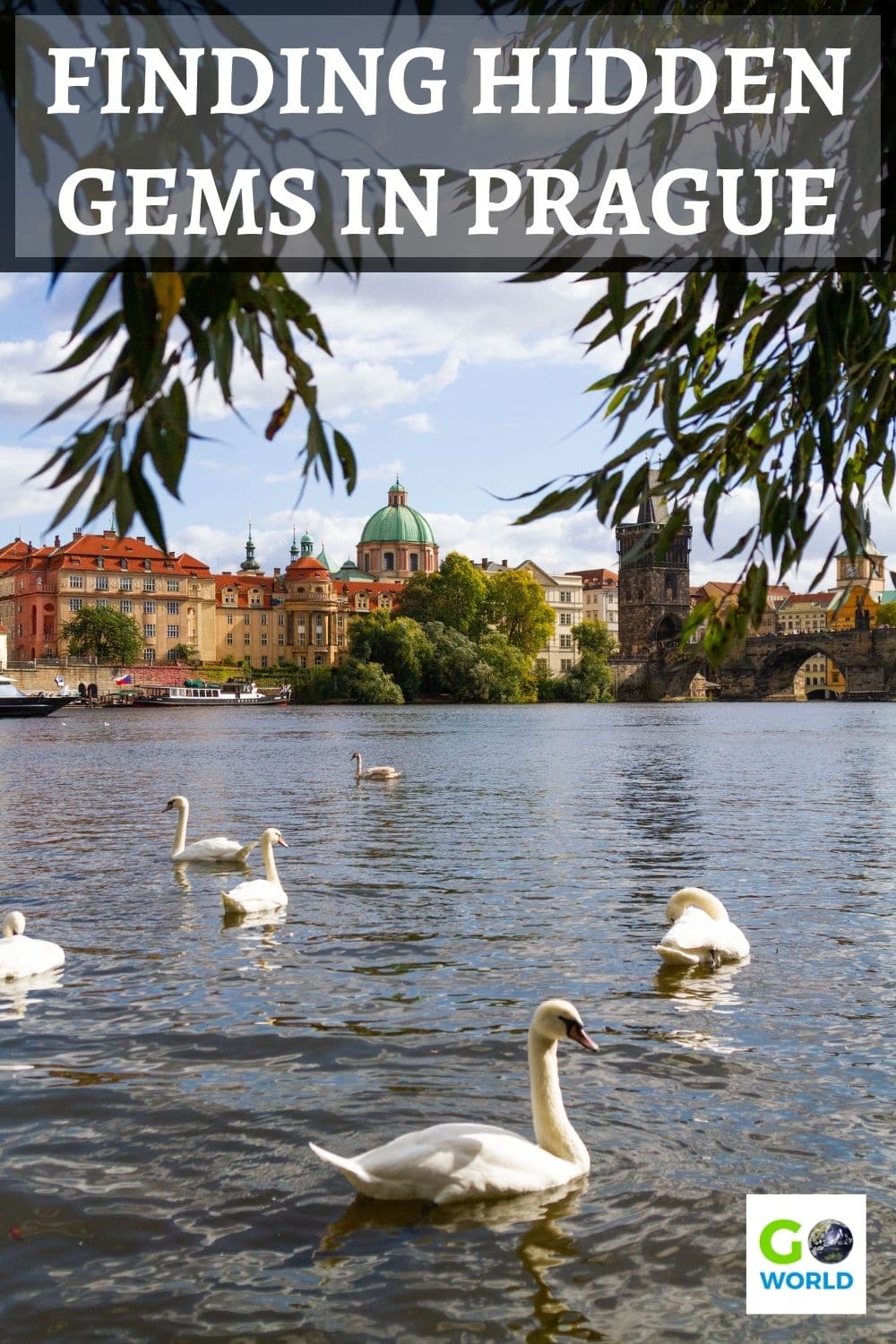
Hidden Gems Outside Prague
Many of the millions of tourists visiting Prague use the city as a base to explore other charming cities in the Czech countryside. There is the spa town of Karlovy Vary or Český Krumlov with its cobbled streets and castle.
Plus Kutrá Hora with the famous Sedlec Bone Church adorned with bizarre sculptures made from the bones of 40,000 people. All these places are likely to be as congested as Prague itself. So why not pay a call on cities that are still undiscovered gems?
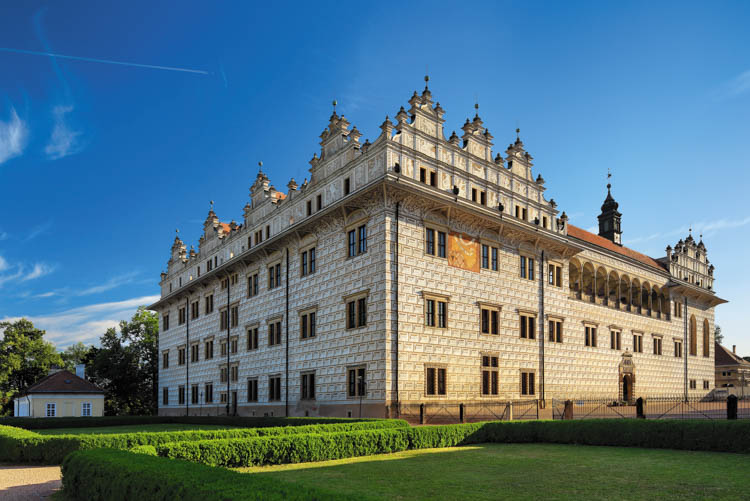
Litomyšl
Just 100 miles east of Prague, the small town of Litomyšl is worth a day of exploring. Its charms include a town square nearly five football fields long with a fifteenth-century town hall and arcades allowing townspeople to shop without getting rained on.
Litomyšl’s highlight, however, is a hilltop Renaissance chateau dating from the late 1500s that’s a UNESCO World Heritage Site.
Huge murals of battle scenes as well as biblical and mythological scenes adorn the exterior. Meanwhile, an inner courtyard features arcades that are three stories tall. Inside, the highlight is an 18th-century theater with painted stage sets.
Elsewhere, stroll through lavishly furnished ceremonial rooms including parlors, a library and a dining room where seven European presidents once dined. In addition, don’t neglect to visit the outbuildings, especially the apartment where the chateau’s brewer once resided.
It’s the birthplace of the beloved Czech composer Bedřich Smetana, the brewer’s 11th child and first son. The apartment has period furniture and relics like reproductions of Smetana’s letters, in which Czech readers will observe the composer’s bad spelling.
Elsewhere in town, there’s a very interesting regional museum with Czech folk costumes. Also, the former Church of The Discovery of the Holy Cross is now a museum with revolving art exhibits and the Portmoneum.
This is a formerly private home whose owner in the 1920s allowed the painter Josef Váchal to cover the walls and even the furniture with bizarre graphic representations.
These included depictions of demons, ghosts, imps, Biblical scenes, signs of the zodiac and even Hindu symbols. The vibrantly bright images are both a tad disturbing and unforgettable at the same time.
Litomyšl has also long been the site of many cultural festivals, including the International Smetana Opera Festival in June and July.
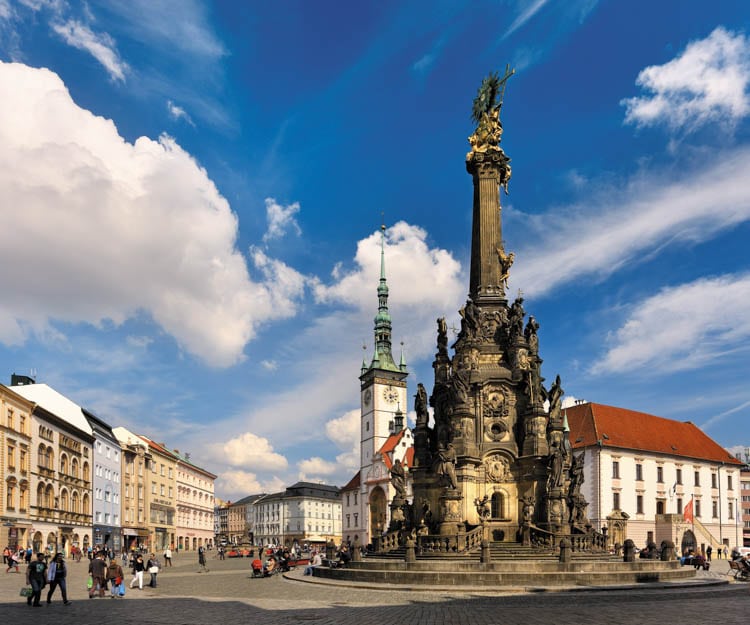
Olomouc: An Alternative to Prague
In the Czech region of Moravia, about a two-hour train ride from Prague is the town of Olomouc. There are so many Gothic and Baroque buildings inside the city center that the New York Times carried a piece in 2019 proposing visitors forgo a visit to crowded Prague. Instead, it recommends they go to Olomouc with all the charm of the Czech capital and a tiny fraction of the tourists.
A university town of about 100,000, Olomuoc’s delightful town center is surrounded by a ring of thick walls and moats. Inside are winding, cobblestoned streets that mimic those in Prague.
In the town’s main square, your eyes will go first to the 100-foot-tall Holy Trinity Column. The column is adorned with 18 sculptures of saints, 12 reliefs of the apostles and a sculpture of the Assumption of Mary. It is topped with the Holy Trinity made of gilded copper.
The largest such monument in the country, it is also a UNESCO Heritage Site. Nearby, an astronomical clock like Prague’s is on the walls of the town hall that’s been rebuilt many times over the centuries. Its most recent iteration was built by the communists in the 1950s depicting happy socialist workers.
Two of the city’s huge Baroque fountains are in the town square, including one of Hercules standing astride a pit of writhing serpents.
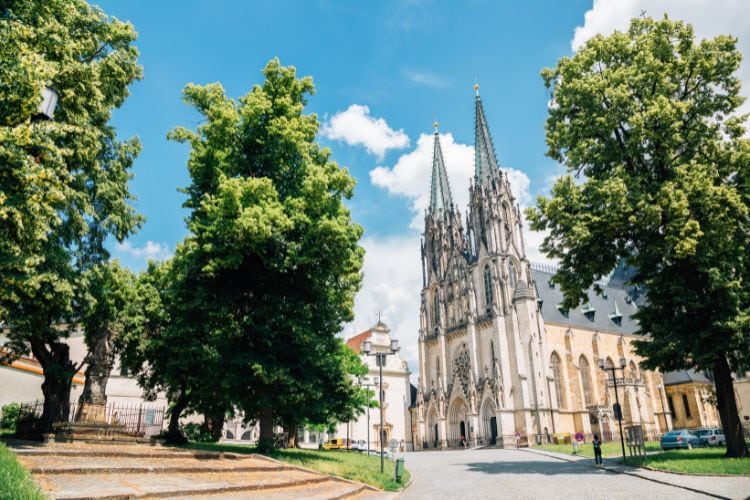
More Gems of Olomouc
Elsewhere, the lavish Archbishop’s Palace is one of two in Europe that’s open to the public. Both Pope John Paul II and Vaclav Havel have visited there and its Throne Hall is where 18-year-old Franz Joseph I assumed the rule of the Austrian Empire in 1848.
The town’s St. Wenceslas Cathedral has undergone several reconstructions and is a hodgepodge or architectural styles. The bells in its three towers ring the noon hour at 11 a.m., paying homage to a trick played on an invading army to make them think it was later than it was.
Also nearby is the Archdiocesan Museum, the town’s pride and joy. Specifically, put together at the request of Pope John Paul II, it has liturgical artwork spanning the centuries. Plus, there are a variety of other eye-catching relics, like a gilded 17th-century coach. Think of it as a Rococo Rolls Royce.
At one of the many cafes and restaurants throughout town, sample the local delicacy which is a form of flavorful but smelly cheese. And if you’re as charmed by the town as you no doubt will be, go to the modern fountain in the town square. Legend has it that if you rub the tail of the dolphin in the fountain, you will one day return to Olomouc.
If You Go
Best Tips & Tools to Plan Your Trip
More information on Prague, Litomyšl, and Olomouc, as well as accommodations and restaurants in each city and how to travel between them, can be found at www.visitczechrepublic.com
Author Bio: Ohio-based travel writer Rich Warren travels the U.S. and the world looking for offbeat and off-the-beaten-path stories. He is a graduate of the Elf School of Reykjavik and can tell you what the Amish wear to the beach in Florida.

